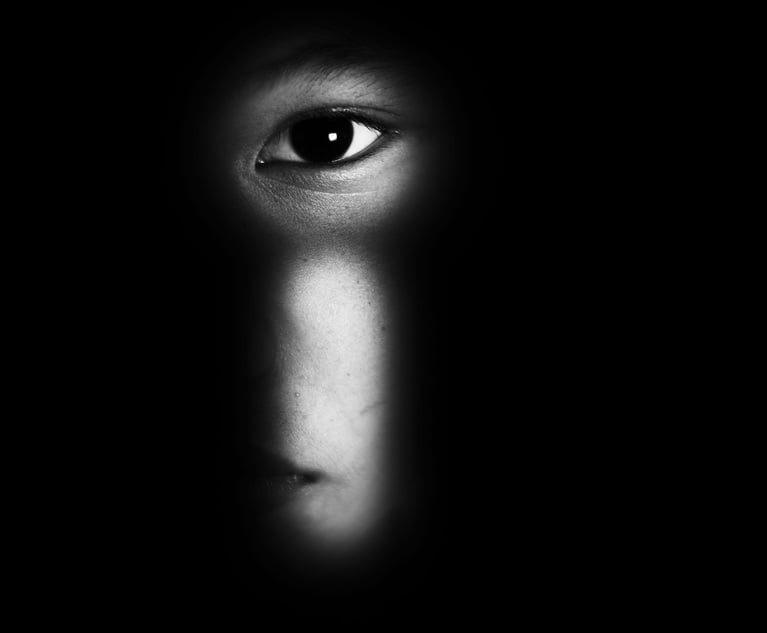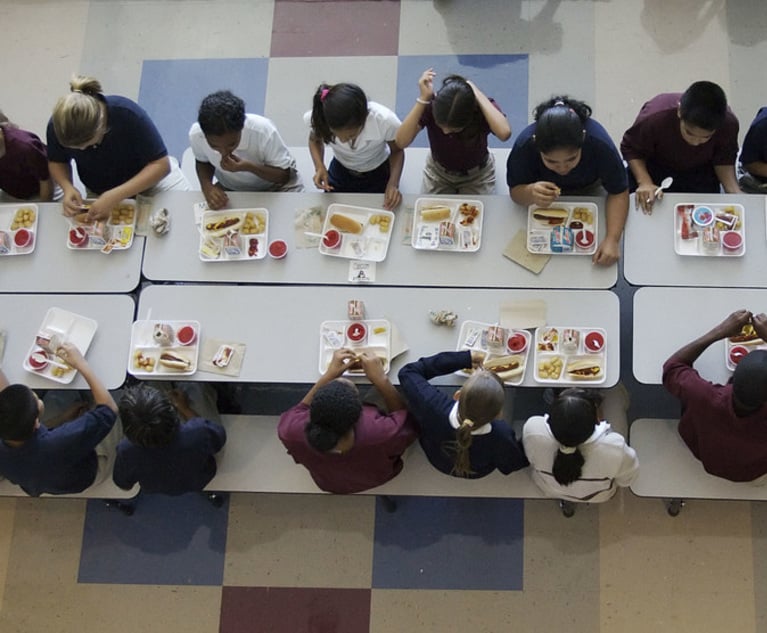 iStock
iStockDefinition of 'Familial Relationship' Expanded for Bystander Claim
OP-ED: An engagement ring or a wedding ring is no longer considered as significant, as it was in days past, to create a family. The law must continuously expand and adjust to keep up with society and remain viable.
January 04, 2019 at 12:00 PM
5 minute read
On Aug.17, 2018, the court upheld a Portee (bystander) claim for the negligent infliction of emotional distress (NIED) even though the bystander was not related to the deceased infant or the infant's biological parent. Moreland v. Parks, ____ N.J. Super. ____ ( App. Div. 2018).
On Jan. 30, 2009, two-year old I'Maya Moreland, while holding the hand of Valerie Benning waiting to cross the street, was killed when struck by a vehicle and thrown 65 feet. I'Maya was not Benning's biological daughter; she was the daughter of I'Asia Moreland, Benning's same-sex partner.
In order to determine whether Benning's relationship with the decedent infant qualified as a “familial relationship” so as to permit an NIED claim, the court looked first at the relationship between Benning and I'Asia. They met and started dating in 2007, and started living together approximately 17 months before the accident, during which time they shared responsibility for the care of I'Maya as well as I'Asia's other biological child. Benning's godson also lived in the same household at the time. I'Maya was approximately 13 months old when Benning and I'Asia began their romantic relationship; within a few weeks thereafter I'Maya started calling Benning “mom.” In the ambulance, on the way to the hospital after the accident, Benning provided the EMT with I'Maya's medical history and I'Maya's likes and dislikes.
In the hospital, when Benning was told that I'Maya died, Benning became hysterical, had to be placed in restraints and agreed to be sedated so she could say her final farewells to I'Maya. Benning participated in I'Maya's funeral arrangements, including borrowing money from her relatives to help finance the funeral. At her deposition, when asked to describe her reaction immediately after the accident, Benning testified that “the death of anyone's child is devastating, but to talk about your own or one that you love like your own is even harder.”
Benning and I'Asia became engaged almost three years after the accident and married approximately five years after the accident.
Under Portee v. Jaffee, 84 N.J. 88, 101 (1980), an NIED claim requires proof of four elements:
- negligence causing the death or serious physical injury of another;
- a marital or intimate, familial relationship between plaintiff and the injured person;
- observation of the death or injury which causes
- emotional distress of plaintiff.
The issue before the court, in reversing and remanding the trial court's granting defendant's summary judgment motion, was whether Benning's relationship fell within the second (familial) requirement. In finding that she did, the court properly pointed out that
[T]he social and legal concept of “family” has significantly evolved since the Court decided Portee in 1980. Thirty-eight years ago gay, lesbian, and transgender people were socially shunned and legally unprotected against invidious discrimination ….The notion of same-sex couples and their children constituting a “familial relationship” worthy of legal recognition was considered by a significant number of our fellow citizens as socially and morally repugnant and legally absurd.
However, the court, in rather emphatic terms, noted that society's attitudes have changed and the law has progressed to meet the new mores of society, i.e., “the overwhelming number of our fellow citizens now unequivocally reject this shameful, morally untenable bigotry; our laws, both legislatively and through judicial decisions, now recognize and protect the rights of LGBTQ people to equal dignity and treatment under law.”
Interpreting the “familial relationship ” requirement of Portee, the court recognized that such a relationship amounts to a “stable, enduring, substantial, and mutually supportive (relationship) … that is cemented by strong emotional bonds and provides … deep and pervasive emotional security.” In holding that Benning's relationship met this standard, the court noted that “a rational jury can find that Benning was a de facto mother to this child, and felt her loss as deeply as any parent facing that horrific event.”
In order to uphold Benning's bystander claim, the court had to extend Portee not only to include gays but also extend it from allowing such a claim for a fiancée, Dunphy v. Gregor, 136 N.J. 99 (1994), to Benning, who was not yet engaged to I'Asia.
Moreland represents a continued expansion of Portee. Indeed, prerequisite #3 (observation) was previously extended, by this author, to permit a plaintiff to recover without actually observing the horrific event (child burning to death in house fire) so long as the plaintiff (mother) was “sensorially aware” of it (knew her daughter was in the house as the plaintiff watched it burn down). Ortiz v. Pittenger, 382 N.J. Super. 552 (Law Div. 2004).
The decision in Moreland is significant because it demonstrates how the law is not stagnant but changes as society changes. In effect, this decision recognizes, as this author did while sitting in the family division, that in today's environment, an engagement ring or a wedding ring is no longer considered as significant, as it was in days past, to create a family. Therefore, the law must continuously expand and adjust to keep up with society and remain viable.
Louis Locascio, a Monmouth County Superior Court judge from 1992 until 2009, is now of counsel with the Red Bank office of Gold, Albanese, Barletti & Locascio, where he heads up their civil and family mediation/arbitration department. He is a certified civil and criminal trial lawyer.
|This content has been archived. It is available through our partners, LexisNexis® and Bloomberg Law.
To view this content, please continue to their sites.
Not a Lexis Subscriber?
Subscribe Now
Not a Bloomberg Law Subscriber?
Subscribe Now
NOT FOR REPRINT
© 2024 ALM Global, LLC, All Rights Reserved. Request academic re-use from www.copyright.com. All other uses, submit a request to [email protected]. For more information visit Asset & Logo Licensing.
You Might Like
View All
As Trafficking, Hate Crimes Rise in NJ, State's Federal Delegation Must Weigh in On New UN Proposal
4 minute read
Appellate Court's Decision on Public Employee Pension Eligibility Helps the Judiciary
5 minute read
Where CFPB Enforcement Stops Short on Curbing School Lunch Fees, Class Action Complaint Steps Up
5 minute read
'Confusion Where Previously There Was Clarity': NJ Supreme Court Should Void Referral Fee Ethics Opinion
4 minute readTrending Stories
Who Got The Work
Michael G. Bongiorno, Andrew Scott Dulberg and Elizabeth E. Driscoll from Wilmer Cutler Pickering Hale and Dorr have stepped in to represent Symbotic Inc., an A.I.-enabled technology platform that focuses on increasing supply chain efficiency, and other defendants in a pending shareholder derivative lawsuit. The case, filed Oct. 2 in Massachusetts District Court by the Brown Law Firm on behalf of Stephen Austen, accuses certain officers and directors of misleading investors in regard to Symbotic's potential for margin growth by failing to disclose that the company was not equipped to timely deploy its systems or manage expenses through project delays. The case, assigned to U.S. District Judge Nathaniel M. Gorton, is 1:24-cv-12522, Austen v. Cohen et al.
Who Got The Work
Edmund Polubinski and Marie Killmond of Davis Polk & Wardwell have entered appearances for data platform software development company MongoDB and other defendants in a pending shareholder derivative lawsuit. The action, filed Oct. 7 in New York Southern District Court by the Brown Law Firm, accuses the company's directors and/or officers of falsely expressing confidence in the company’s restructuring of its sales incentive plan and downplaying the severity of decreases in its upfront commitments. The case is 1:24-cv-07594, Roy v. Ittycheria et al.
Who Got The Work
Amy O. Bruchs and Kurt F. Ellison of Michael Best & Friedrich have entered appearances for Epic Systems Corp. in a pending employment discrimination lawsuit. The suit was filed Sept. 7 in Wisconsin Western District Court by Levine Eisberner LLC and Siri & Glimstad on behalf of a project manager who claims that he was wrongfully terminated after applying for a religious exemption to the defendant's COVID-19 vaccine mandate. The case, assigned to U.S. Magistrate Judge Anita Marie Boor, is 3:24-cv-00630, Secker, Nathan v. Epic Systems Corporation.
Who Got The Work
David X. Sullivan, Thomas J. Finn and Gregory A. Hall from McCarter & English have entered appearances for Sunrun Installation Services in a pending civil rights lawsuit. The complaint was filed Sept. 4 in Connecticut District Court by attorney Robert M. Berke on behalf of former employee George Edward Steins, who was arrested and charged with employing an unregistered home improvement salesperson. The complaint alleges that had Sunrun informed the Connecticut Department of Consumer Protection that the plaintiff's employment had ended in 2017 and that he no longer held Sunrun's home improvement contractor license, he would not have been hit with charges, which were dismissed in May 2024. The case, assigned to U.S. District Judge Jeffrey A. Meyer, is 3:24-cv-01423, Steins v. Sunrun, Inc. et al.
Who Got The Work
Greenberg Traurig shareholder Joshua L. Raskin has entered an appearance for boohoo.com UK Ltd. in a pending patent infringement lawsuit. The suit, filed Sept. 3 in Texas Eastern District Court by Rozier Hardt McDonough on behalf of Alto Dynamics, asserts five patents related to an online shopping platform. The case, assigned to U.S. District Judge Rodney Gilstrap, is 2:24-cv-00719, Alto Dynamics, LLC v. boohoo.com UK Limited.
Featured Firms
Law Offices of Gary Martin Hays & Associates, P.C.
(470) 294-1674
Law Offices of Mark E. Salomone
(857) 444-6468
Smith & Hassler
(713) 739-1250






